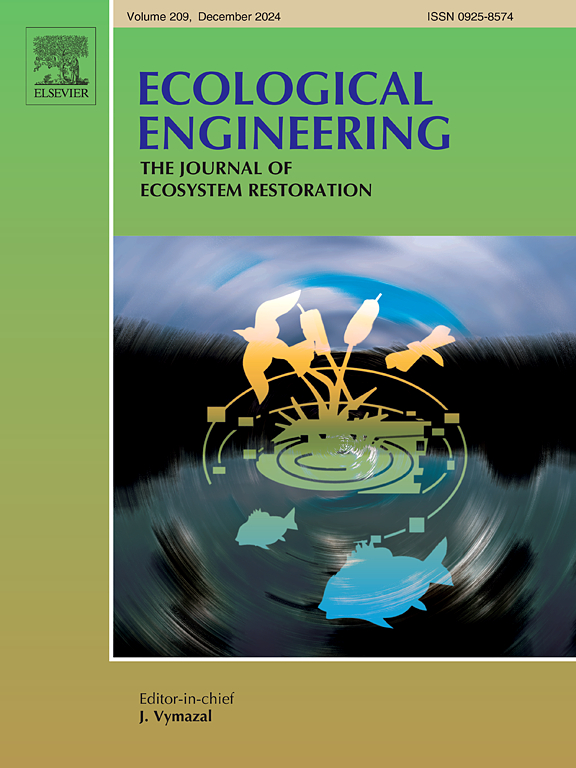综合整治与生态修复工程驱动江西省生态系统服务功能变化及其地形梯度效应
IF 4.1
2区 环境科学与生态学
Q1 ECOLOGY
引用次数: 0
摘要
在生态文明建设的大背景下,为增强区域生态系统服务能力,综合整治与生态修复工程得到了广泛实施。然而,CCERPs影响跨地形梯度ESs的机制尚不清楚。本文分析了2000-2010年和2010-2023年江西省5种生态环境的变化特征,以及5种类型生态环境的面积和空间分布特征。利用XGBoost-SHAP模型,我们探讨了CCERPs在三个地形梯度(Rank1、Rank2和Rank3)上对ESs变化的驱动机制和非线性效应。结果表明:2010-2023年CCERPs总面积较前一时期增加18.54×108m2;退耕还林工程(GGP)和低效森林整治工程(LFRP)在两个时期的面积都最大,合计超过70%。不同地形梯度的ESs变化和CCERP分布具有显著的空间异质性:Rank3的ESs持续改善,而Rank1的ESs波动较大。80%以上的建设用地复垦(CLRP)、旱地改稻(DCP)和水体恢复工程(WRP)集中在Rank1和Rank2, 70%以上的GGP和LFRP分布在Rank2和Rank3。CLRP显著改善了Rank1的碳储量、生境质量和净初级生产力;DCP提高了Rank1和Rank2的土壤保持力(SR)和水保持力(WR);GGP和LFRP对所有ESs均有正向影响,其中对Rank2和Rank3的CS和HQ影响最为显著。Rank1和Rank2的CS和HQ对建设用地扩张较为敏感,Rank2和Rank3的NPP、SR和WR受降水和温度变化的影响较大。非CCERPs因素引起的ESs下降抵消了CCERPs带来的增强。在不同的地形梯度下,每种类型的CCERP都表现出增强优势ESs的最佳实施范围。在此范围内,CCERP面积的增加有效地促进了ESs的改善。该研究加深了对CCERPs与ESs跨地形梯度变化关系的认识,为今后CCERPs的分区实施和精准管理提供了科学参考。本文章由计算机程序翻译,如有差异,请以英文原文为准。
Comprehensive consolidation and ecological restoration projects drive the variation of ecosystem services and their terrain gradient effect in Jiangxi Province, China
Under the background of ecological civilization construction, comprehensive consolidation and ecological restoration projects (CCERPs) have been widely implemented to enhance regional ecosystem services (ESs). However, the mechanisms by which CCERPs influence ESs across terrain gradients remain unclear. This study analyzed the variations of five ESs, as well as the area and spatial distribution of five types of CCERPs in Jiangxi Province during 2000–2010 and 2010–2023. Using the XGBoost-SHAP model, we explored the driving mechanisms and nonlinear effects of CCERPs on ESs variation across three terrain gradients (Rank1, Rank2, and Rank3). Results show that the total area of CCERPs increased by in 2010–2023 compared to the previous period. Grain for green project (GGP) and low-efficiency forest renovation project (LFRP) accounted for the largest areas in both periods, together exceeding 70 %. Significant spatial heterogeneity in ESs variation and CCERP distribution was observed across terrain gradients: ESs in Rank3 exhibited continuous improvement, while those in Rank1 showed high fluctuation. Over 80 % of construction land reclamation project (CLRP), dryland-to-paddy conversion project (DCP), and water restoration project (WRP) were concentrated in Rank1 and Rank2, while more than 70 % of GGP and LFRP were distributed in Rank2 and Rank3. CLRP significantly improved carbon storage (CS), habitat quality (HQ), and net primary productivity (NPP) in Rank1; DCP enhanced soil retention (SR) and water retention (WR) in Rank1 and Rank2; GGP and LFRP had positive effects on all ESs, with the most pronounced impact on CS and HQ in Rank2 and Rank3. CS and HQ in Rank1 and Rank2 were more sensitive to construction land expansion, while NPP, SR, and WR in Rank2 and Rank3 were more influenced by precipitation and temperature change. Declines in ESs caused by non-CCERPs factors offset the enhancement brought by CCERPs. Across different terrain gradients, each type of CCERP exhibited an optimal implementation range for enhancing dominant ESs. Within this range, increases in CCERP area effectively promoted ESs improvement. This study deepens the understanding of the relationship between CCERPs and ESs variation across terrain gradients and provides a scientific reference for the zoned implementation and precise management of future CCERPs.
求助全文
通过发布文献求助,成功后即可免费获取论文全文。
去求助
来源期刊

Ecological Engineering
环境科学-工程:环境
CiteScore
8.00
自引率
5.30%
发文量
293
审稿时长
57 days
期刊介绍:
Ecological engineering has been defined as the design of ecosystems for the mutual benefit of humans and nature. The journal is meant for ecologists who, because of their research interests or occupation, are involved in designing, monitoring, or restoring ecosystems, and can serve as a bridge between ecologists and engineers.
Specific topics covered in the journal include: habitat reconstruction; ecotechnology; synthetic ecology; bioengineering; restoration ecology; ecology conservation; ecosystem rehabilitation; stream and river restoration; reclamation ecology; non-renewable resource conservation. Descriptions of specific applications of ecological engineering are acceptable only when situated within context of adding novelty to current research and emphasizing ecosystem restoration. We do not accept purely descriptive reports on ecosystem structures (such as vegetation surveys), purely physical assessment of materials that can be used for ecological restoration, small-model studies carried out in the laboratory or greenhouse with artificial (waste)water or crop studies, or case studies on conventional wastewater treatment and eutrophication that do not offer an ecosystem restoration approach within the paper.
 求助内容:
求助内容: 应助结果提醒方式:
应助结果提醒方式:


